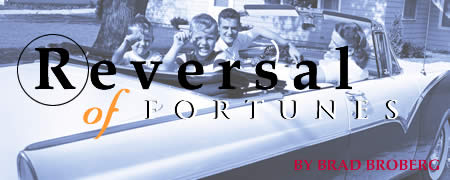
Martina Morris didn't just write a book. She held up a mirror.
Plenty of people see themselves in the charts, graphs and analyses that fill the pages of Divergent Paths and led Morris and her three co-authors to a sobering conclusion—the American Dream is becoming more and more elusive.
The reasons are complex and the fallout widespread, but the bottom line is simple. Millions of workers who got their start in the "new economy"—including many with college degrees—are climbing the economic ladder much more slowly than the previous generation. The distance between the top and bottom rungs is widening and the population at the bottom is growing.
Based upon a pair of government surveys, Divergent Paths: Economic Mobility in the New American Labor Market compares the wage growth of two groups of white males over the span of 16 years. The first study tracked a cohort from 1966 until 1981. The second tracked a cohort from 1979 through 1994.

Like miners combing a mother lode, Morris, a UW professor of sociology and statistics, and her co-authors pulled numerous nuggets from the studies, but one outweighs them all. Ninety percent of all workers surveyed—high school dropouts, high school graduates, those with some college and those with bachelor's degrees or better—are doing worse economically now than if they had been born 20 years earlier.
The key word is all. This is not a story of "the rich getting richer and the poor getting poorer," writes Morris and her colleagues, "rather, nearly everyone is losing some ground, with those at the bottom losing the most."
Look at the final year's wages for each cohort and then translate them into 1999 dollars. Adjusted for inflation (using the most conservative deflator available, Morris quickly notes), the median hourly wage for a high school graduate plunged 21 percent (from $16.36 to $12.93). For someone with a bachelor's degree or better, wages dipped 8 percent (from $20.01 to $18.42).
This, together with more and more people congregating at the bottom of the employment pyramid, means that "the heart of the middle class has been hollowed out" with 40 percent fewer workers achieving the earnings that defined America's middle class in the 1970s, according to Morris and her colleagues.
Morris has fielded e-mail after e-mail from folks saying they're trapped in the trend Divergent Paths documents. It's a surprisingly robust response considering the book's modest publicity, says Morris.
Then again, it's natural for people to seize on signs that they're not alone. "They know things aren't quite right," says Morris, "but they're not sure why."
Given the economy's stellar performance in the 1990s, some may wonder whether the sour notes sounded in Divergent Paths are already out of tune. Additional data collected from the second cohort in 1996 and 1998 indicate wages were on the rise during the final years of the Clinton Administration. The median hourly wage grew for all four subgroups—high school dropouts, high school graduates, men with some college and college graduates—with college grads making the greatest gains.
Even if wages eventually reach the same level as those in the first cohort, it will be too late to match the first group's lifetime income. The period in a worker's life analyzed in Divergent Paths represents 70 percent of a person's lifetime wage gains, say the authors. During that time, members of the second cohort lost between $40,000 (college grads) and $116,000 (high school grads) in cumulative earnings compared to their counterparts in the first group.
Divergent Paths capped five years of work by Morris and her co-authors, including her husband, Mark Handcock, a professor of statistics and sociology at the UW. The other authors are Annette Bernhardt, senior policy analyst at the Brennan Center for Justice at New York University, and Marc Scott, assistant professor of educational statistics at New York University.